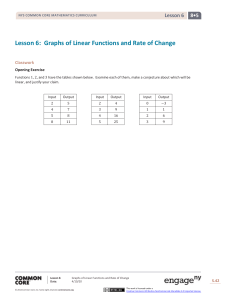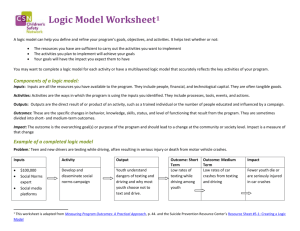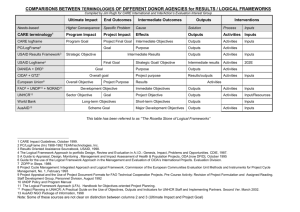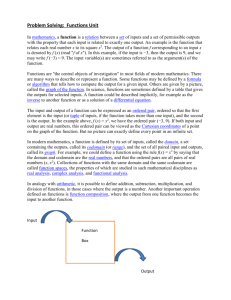Lesson 6 - Great Minds
advertisement
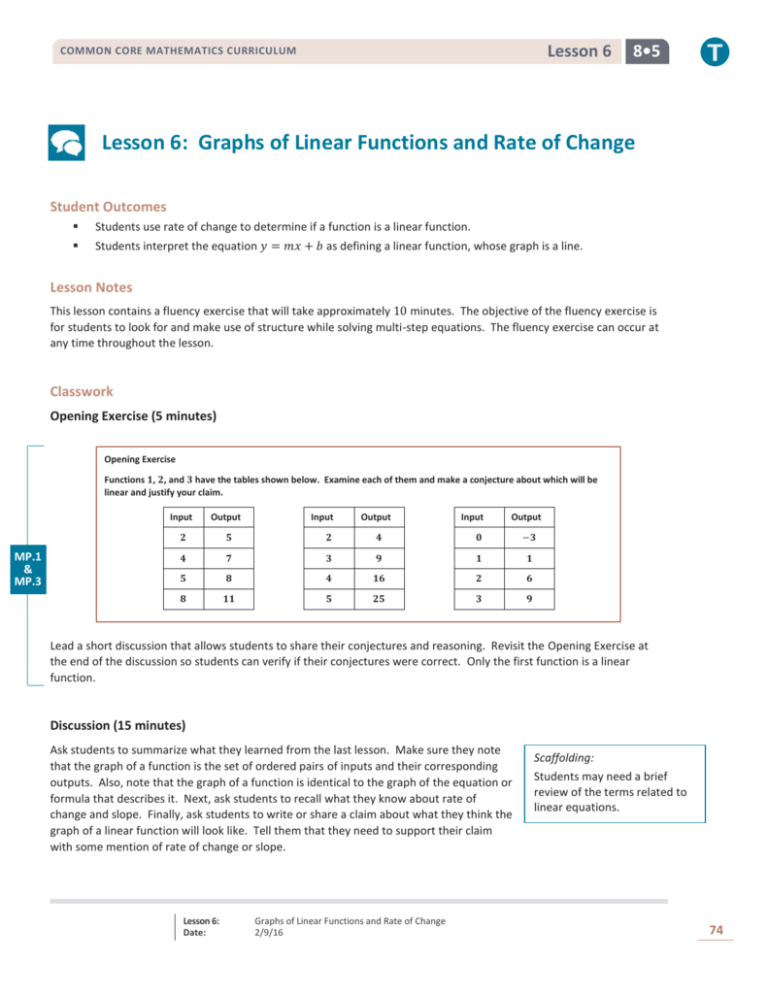
Lesson 6 COMMON CORE MATHEMATICS CURRICULUM 8•5 Lesson 6: Graphs of Linear Functions and Rate of Change Student Outcomes Students use rate of change to determine if a function is a linear function. Students interpret the equation 𝑦 = 𝑚𝑥 + 𝑏 as defining a linear function, whose graph is a line. Lesson Notes This lesson contains a fluency exercise that will take approximately 10 minutes. The objective of the fluency exercise is for students to look for and make use of structure while solving multi-step equations. The fluency exercise can occur at any time throughout the lesson. Classwork Opening Exercise (5 minutes) Opening Exercise Functions 𝟏, 𝟐, and 𝟑 have the tables shown below. Examine each of them and make a conjecture about which will be linear and justify your claim. Input MP.1 & MP.3 Output Input Output Input Output 𝟐 𝟓 𝟐 𝟒 𝟎 −𝟑 𝟒 𝟕 𝟑 𝟗 𝟏 𝟏 𝟓 𝟖 𝟒 𝟏𝟔 𝟐 𝟔 𝟖 𝟏𝟏 𝟓 𝟐𝟓 𝟑 𝟗 Lead a short discussion that allows students to share their conjectures and reasoning. Revisit the Opening Exercise at the end of the discussion so students can verify if their conjectures were correct. Only the first function is a linear function. Discussion (15 minutes) Ask students to summarize what they learned from the last lesson. Make sure they note that the graph of a function is the set of ordered pairs of inputs and their corresponding outputs. Also, note that the graph of a function is identical to the graph of the equation or formula that describes it. Next, ask students to recall what they know about rate of change and slope. Finally, ask students to write or share a claim about what they think the graph of a linear function will look like. Tell them that they need to support their claim with some mention of rate of change or slope. Lesson 6: Date: Graphs of Linear Functions and Rate of Change 2/9/16 Scaffolding: Students may need a brief review of the terms related to linear equations. 74 Lesson 6 COMMON CORE MATHEMATICS CURRICULUM 8•5 Suppose a function can be described by an equation in the form of 𝑦 = 𝑚𝑥 + 𝑏 and that the function assigns the values shown in the table below: Input Output 2 5 3.5 8 4 9 4.5 10 We want to determine whether or not this is a linear function and if so, we want to determine what the linear equation is that describes the function. In Module 4, we learned that linear equations graph as lines and that all lines are graphs of linear equations. Therefore, if we can show that a linear equation produces the same results as the function, then we know that the function is a linear function. How did we compute the slope of the graph of a line? To compute slope, we found the difference in 𝑦-values compared to the distance in 𝑥-values. We used the formula: 𝑦1 − 𝑦2 𝑚= 𝑥1 − 𝑥2 Based on what we learned in the last lesson about the graphs of functions (i.e., the input and corresponding output can be expressed as an ordered pair), we can look at the formula as the following: 𝑚= 𝑜𝑢𝑡𝑝𝑢𝑡1 − 𝑜𝑢𝑡𝑝𝑢𝑡2 𝑖𝑛𝑝𝑢𝑡1 − 𝑖𝑛𝑝𝑢𝑡2 If the rate of change (i.e., slope) is the same for each pair of inputs and outputs, then we know we are looking at a linear function. To that end, we begin with the first two rows of the table: 5−8 −3 = 2 − 3.5 −1.5 =2 Calculate the rate of change between rows two and three and rows three and four. Sample student work: 8−9 −1 = 3.5 − 4 −0.5 9 − 10 −1 = 4 − 4.5 −0.5 =2 What did you notice? =2 The rate of change between each pair of inputs and outputs was 2. To be thorough, we could also look at rows one and three and one and four, there are many combinations to inspect. What will the result be? We expect the rate of change to be 2. Lesson 6: Date: Graphs of Linear Functions and Rate of Change 2/9/16 75 Lesson 6 COMMON CORE MATHEMATICS CURRICULUM Verify your claim by checking one more pair. Sample student work: 5 − 10 5 = 2 − 4.5 −2.5 or 5 − 9 −4 = 2 − 4 −2 =2 =2 8•5 With this knowledge, we have answered the first question because the rate of change is equal to a constant (in this case, 2) between pairs of inputs and their corresponding outputs, then we know that we have a linear function. Next, we find the equation that describes the function. At this point, we expect the equation to be described by 𝑦 = 2𝑥 + 𝑏 because we know the slope is 2. Since the function assigns 5 to 2, 8 to 3.5, etc., we can use that information to determine the value of 𝑏 by solving the following equation. Using the assignment of 5 to 2: 5 = 2(2) + 𝑏 5= 4+𝑏 1=𝑏 Now that we know that 𝑏 = 1 we can substitute into 𝑦 = 2𝑥 + 𝑏, which results in the equation 𝑦 = 2𝑥 + 1. The equation that describes the function is 𝑦 = 2𝑥 + 1 and the function is a linear function. What would the graph of this function look like? The following table represents the outputs that a function would assign to given inputs. We want to know if the function is a linear function, and if so, what linear equation describes the function. −2 4 3 9 4.5 20.25 5 25 We need to inspect the rate of change between pairs of inputs and their corresponding outputs. Sample student work: 4−9 −5 = −2 − 3 −5 =1 4 − 25 −21 = −2 − 5 −7 =3 9 − 25 −16 = 3−5 −2 =8 What do you notice about the rate of change and what does this mean about the function? Output Compare at least three pairs of inputs and their corresponding outputs. Input How should we begin? It would be a line because the rule that describes the function in the form of 𝑦 = 𝑚𝑥 + 𝑏 are equations known to graph as lines. The rate of change was different for each pair of inputs and outputs inspected, which means that it is not a linear function. If this were a linear function, what would we expect to see? If this were a linear function, each inspection of the rate of change would result in the same number (similar to what we saw in the last problem where each result was 2). Lesson 6: Date: Graphs of Linear Functions and Rate of Change 2/9/16 76 Lesson 6 COMMON CORE MATHEMATICS CURRICULUM 8•5 We have enough evidence to conclude that this function is not a linear function. Would the graph of this function be a line? Explain. No, the graph of this function would not be a line. Only linear functions, whose equations are in the form of 𝑦 = 𝑚𝑥 + 𝑏, graph as lines. Since this function does not have a constant rate of change it will not graph as a line. Exercise (5 minutes) Students work independently or in pairs to complete the Exercise. Exercise A function assigns the inputs and corresponding outputs shown in the table below. Input a. Output 𝟏 𝟐 𝟐 −𝟏 𝟒 −𝟕 𝟔 −𝟏𝟑 Is the function a linear function? Check at least three pairs of inputs and their corresponding outputs. 𝟐 − (−𝟏) 𝟑 = 𝟏−𝟐 −𝟏 = −𝟑 −𝟕 − (−𝟏𝟑) 𝟔 = 𝟒−𝟔 −𝟐 = −𝟑 𝟐 − (−𝟕) 𝟗 = 𝟏−𝟒 −𝟑 = −𝟑 Yes, the rate of change is the same when I check pairs of inputs and corresponding outputs. Each time it is equal to −𝟑. Since the rate of change is the same, then I know it is a linear function. b. What equation describes the function? Using the assignment of 𝟐 to 𝟏: 𝟐 = −𝟑(𝟏) + 𝒃 𝟐 = −𝟑 + 𝒃 𝟓=𝒃 The equation that describes the function is 𝒚 = −𝟑𝒙 + 𝟓. c. What will the graph of the function look like? Explain. The graph of the function will be a line. Since the function is a linear function that can be described by the equation 𝒚 = −𝟑𝒙 + 𝟓, then it will graph as a line because equations of the form 𝒚 = 𝒎𝒙 + 𝒃 graph as lines. Lesson 6: Date: Graphs of Linear Functions and Rate of Change 2/9/16 77 Lesson 6 COMMON CORE MATHEMATICS CURRICULUM 8•5 Fluency Exercise (10 minutes) In this exercise students solve three sets of similar multi-step equations. Display the equations one at a time. Each equation should be solved in less than one minute; however, students may need slightly more time for the first set and less time for the next two sets if they notice the pattern. Consider having students work on white boards and have them show you their solutions for each problem. The three sets of equations and their answers are below. Set 1: Answer for each problem is 𝑥 = −2 Set 2: Answer for each problem is 3 𝑥=− 14 Set 3: Answer for each problem is 𝑥=5 3𝑥 + 2 = 5𝑥 + 6 6 − 4𝑥 = 10𝑥 + 9 5𝑥 + 2 = 9𝑥 − 18 4(5𝑥 + 6) = 4(3𝑥 + 2) −2(−4𝑥 + 6) = −2(10𝑥 + 9) 8𝑥 + 2 − 3𝑥 = 7𝑥 − 18 + 2𝑥 3𝑥 + 2 5𝑥 + 6 = 6 6 10𝑥 + 9 6 − 4𝑥 = 5 5 2 + 5𝑥 7𝑥 − 18 + 2𝑥 = 3 3 Closing (5 minutes) Summarize, or ask students to summarize, the main points from the lesson: We know that if the rate of change for pairs of inputs and corresponding outputs is the same for each pair, the function is a linear function. We know that we can write linear equations in the form of 𝑦 = 𝑚𝑥 + 𝑏 to express a linear function. We know that the graph of a linear function in the form of 𝑦 = 𝑚𝑥 + 𝑏 will graph as a line because all equations of that form graph as lines. Therefore, if a function can be expressed in the form of 𝑦 = 𝑚𝑥 + 𝑏, the function will graph as a line. Lesson Summary When the rate of change is constant for pairs of inputs and their corresponding outputs, the function is a linear function. We can write linear equations in the form of 𝒚 = 𝒎𝒙 + 𝒃 to express a linear function. From the last lesson we know that the graph of a function is the same as the graph of the equation that describes it. When a function can be described by the linear equation 𝒚 = 𝒎𝒙 + 𝒃, the graph of the function will be a line because the graph of the equation 𝒚 = 𝒎𝒙 + 𝒃 is a line. Exit Ticket (5 minutes) Lesson 6: Date: Graphs of Linear Functions and Rate of Change 2/9/16 78 Lesson 6 COMMON CORE MATHEMATICS CURRICULUM Name 8•5 Date Lesson 6: Graphs of Linear Functions and Rate of Change Exit Ticket 1. 2. Sylvie claims that the table of inputs and outputs below will be a linear function. Is she correct? Explain. Inputs Outputs −3 −25 2 5 8 10 31 54 A function assigns the inputs and corresponding outputs shown in the table below. a. Is the function a linear function? Check at least three pairs of inputs and their corresponding outputs. b. What equation describes the function? c. What will the graph of the function look like? Explain. Lesson 6: Date: Graphs of Linear Functions and Rate of Change 2/9/16 Input Output −2 3 8 −2 10 −3 20 −8 79 Lesson 6 COMMON CORE MATHEMATICS CURRICULUM 8•5 Exit Ticket Sample Solutions 1. Sylvie claims that the table of inputs and outputs will be a linear function. Is she correct? Explain. Inputs −𝟑 𝟐 𝟓 𝟖 Outputs −𝟐𝟓 𝟏𝟎 𝟑𝟏 𝟓𝟒 𝟏𝟎 − 𝟑𝟏 −𝟐𝟏 = 𝟐−𝟓 −𝟑 −𝟐𝟓 − (𝟏𝟎) −𝟑𝟓 = −𝟑 − 𝟐 −𝟓 𝟑𝟏 − 𝟓𝟒 −𝟐𝟑 = 𝟓−𝟖 −𝟑 𝟐𝟑 = 𝟑 =𝟕 =𝟕 No, this is not a linear function. The rate of change was not the same for each pair of inputs and outputs inspected, which means that it is not a linear function. 2. A function assigns the inputs and corresponding outputs shown in the table below. a. Is the function a linear function? Check at least three pairs of inputs and their corresponding outputs. Input 𝟑 − (−𝟐) 𝟓 𝟏 = =− −𝟐 − 𝟖 −𝟏𝟎 𝟐 Output −𝟐 𝟑 𝟖 −𝟐 𝟏𝟎 −𝟑 𝟐𝟎 −𝟖 −𝟐 − (−𝟑) 𝟏 𝟏 = =− 𝟖 − 𝟏𝟎 −𝟐 𝟐 −𝟑 − (−𝟖) 𝟓 𝟏 = =− 𝟏𝟎 − 𝟐𝟎 −𝟏𝟎 𝟐 Yes, the rate of change is the same when I check pairs of inputs and corresponding outputs. Each time it is 𝟏 𝟐 equal to − . Since the rate of change is the same, then I know it is a linear function. b. What equation describes the function? Using the assignment of 𝟑 to – 𝟐: 𝟏 𝟑 = − (−𝟐) + 𝒃 𝟐 𝟑 =𝟏+𝒃 𝟐=𝒃 𝟏 𝟐 The equation that describes the function is 𝒚 = − 𝒙 + 𝟐. c. What will the graph of the function look like? Explain. The graph of the function will be a line. Since the function is a linear function that can be described by the 𝟏 𝟐 equation 𝒚 = − 𝒙 + 𝟐, then it will graph as a line because equations of the form 𝒚 = 𝒎𝒙 + 𝒃 graph as lines. Lesson 6: Date: Graphs of Linear Functions and Rate of Change 2/9/16 80 Lesson 6 COMMON CORE MATHEMATICS CURRICULUM 8•5 Problem Set Sample Solutions 1. A function assigns the inputs and corresponding outputs shown in the table below. a. Input Output 𝟑 𝟗 𝟏𝟐 𝟏𝟓 𝟗 𝟏𝟕 𝟐𝟏 𝟐𝟓 Is the function a linear function? Check at least three pairs of inputs and their corresponding outputs. 𝟗 − 𝟏𝟕 −𝟖 = 𝟑−𝟗 −𝟔 𝟒 = 𝟑 𝟏𝟕 − 𝟐𝟏 −𝟒 = 𝟗 − 𝟏𝟐 −𝟑 𝟒 = 𝟑 𝟐𝟏 − 𝟐𝟓 −𝟒 = 𝟏𝟐 − 𝟏𝟓 −𝟑 𝟒 = 𝟑 Yes, the rate of change is the same when I check pairs of inputs and corresponding outputs. Each time it is equal to b. 𝟒 . Since the rate of change is the same, then I know it is a linear function. 𝟑 What equation describes the function? Using the assignment of 𝟗 to 𝟑: 𝟒 (𝟑) + 𝒃 𝟑 𝟗=𝟒+𝒃 𝟓=𝒃 𝟗= 𝟒 𝟑 The equation that describes the function is 𝒚 = 𝒙 + 𝟓. c. What will the graph of the function look like? Explain. The graph of the function will be a line. Since the function is a linear function that can be described by the 𝟒 𝟑 equation 𝒚 = 𝒙 + 𝟓, it will graph as a line because equations of the form 𝒚 = 𝒎𝒙 + 𝒃 graph as lines. 2. A function assigns the inputs and corresponding outputs shown in the table below. a. Input Output −𝟏 𝟎 𝟏 𝟐 𝟑 𝟐 𝟎 𝟐 𝟖 𝟏𝟖 Is the function a linear function? 𝟐−𝟎 𝟐 = −𝟏 − 𝟎 −𝟏 𝟎 − 𝟐 −𝟐 = 𝟎 − 𝟏 −𝟏 = −𝟐 =𝟐 No, the rate of change is not the same when I check the first two pairs of inputs and corresponding outputs. All rates of change must be the same for all inputs and outputs for the function to be linear. b. What equation describes the function? I am not sure what equation describes the function. It is not a linear function. Lesson 6: Date: Graphs of Linear Functions and Rate of Change 2/9/16 81 Lesson 6 COMMON CORE MATHEMATICS CURRICULUM 3. 8•5 A function assigns the inputs and corresponding outputs shown in the table below. a. Input Output 𝟎. 𝟐 𝟎. 𝟔 𝟏. 𝟓 𝟐. 𝟏 𝟐 𝟔 𝟏𝟓 𝟐𝟏 Is the function a linear function? Check at least three pairs of inputs and their corresponding outputs. 𝟐−𝟔 −𝟒 = 𝟎. 𝟐 − 𝟎. 𝟔 −𝟎. 𝟒 𝟔 − 𝟏𝟓 −𝟗 = 𝟎. 𝟔 − 𝟏. 𝟓 −𝟎. 𝟗 = 𝟏𝟎 = 𝟏𝟎 𝟏𝟓 − 𝟐𝟏 −𝟔 = 𝟏. 𝟓 − 𝟐. 𝟏 −𝟎. 𝟔 = 𝟏𝟎 Yes, the rate of change is the same when I check pairs of inputs and corresponding outputs. Each time it is equal to 𝟏𝟎. Since the rate of change is the same, I know it is a linear function. b. What equation describes the function? Using the assignment of 𝟐 to 𝟎. 𝟐: 𝟐 = 𝟏𝟎(𝟎. 𝟐) + 𝒃 𝟐= 𝟐+𝒃 𝟎=𝒃 The equation that describes the function is 𝒚 = 𝟏𝟎𝒙. c. What will the graph of the function look like? Explain. The graph of the function will be a line. Since the function is a linear function that can be described by the equation 𝒚 = 𝟏𝟎𝒙, it will graph as a line because equations of the form 𝒚 = 𝒎𝒙 + 𝒃 graph as lines. 4. Martin says that you only need to check the first and last input and output values to determine if the function is linear. Is he correct? Explain. Hint: Show an example with a table that is not a function. No, he is not correct. For example, determine if the following input and outputs in the table is a function. Input 𝟏 𝟐 𝟑 Output 𝟗 𝟏𝟎 𝟏𝟐 Using the first and last input and output the rate of change is 𝟗 − 𝟏𝟐 −𝟑 = 𝟏−𝟑 −𝟐 𝟑 = 𝟐 But when you use the first two input and outputs the rate of change is 𝟗 − 𝟏𝟎 −𝟏 = 𝟏−𝟐 −𝟏 =𝟏 Note to teacher: Accept any example where rate of change is different for any two inputs and outputs. Lesson 6: Date: Graphs of Linear Functions and Rate of Change 2/9/16 82 Lesson 6 COMMON CORE MATHEMATICS CURRICULUM 5. 8•5 Is the following graph a graph of a linear function? How would you determine if it is a linear function? It appears to be a linear function. To check, I would organize the coordinates in an input and output table. Next, I would check to see that all the rates of change are the same. If they are the same rates of change, I would use the equation 𝒚 = 𝒎𝒙 + 𝒃 and one of the assignments to write an equation to solve for 𝒃. That information would allow me to determine the equation that represents the function. 6. A function assigns the inputs and corresponding outputs shown in the table below. a. Input Output −𝟔 −𝟓 −𝟒 −𝟐 −𝟔 −𝟓 −𝟒 −𝟐 Is the function a linear function? Check at least three pairs of inputs and their corresponding outputs. −𝟔 − (−𝟓) 𝟏 = −𝟔 − (−𝟓) 𝟏 −𝟓 − (−𝟒) 𝟏 = −𝟓 − (−𝟒) 𝟏 −𝟒 − (−𝟐) 𝟐 = −𝟒 − (−𝟐) 𝟐 =𝟏 =𝟏 =𝟏 Yes, the rate of change is the same when I check pairs of inputs and corresponding outputs. Each time it is equal to 𝟏. Since the rate of change is the same, I know it is a linear function. b. What equation describes the function? Using the assignment of −𝟓 to – 𝟓: −𝟓 = 𝟏(−𝟓) + 𝒃 −𝟓 = −𝟓 + 𝒃 𝟎=𝒃 The equation that describes the function is 𝒚 = 𝒙. c. What will the graph of the function look like? Explain. The graph of the function will be a line. Since the function is a linear function that can be described by the equation 𝒚 = 𝒙, it will graph as a line because equations of the form 𝒚 = 𝒎𝒙 + 𝒃 graph as lines. Lesson 6: Date: Graphs of Linear Functions and Rate of Change 2/9/16 83




